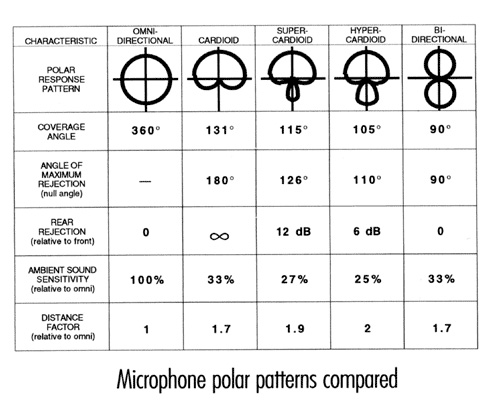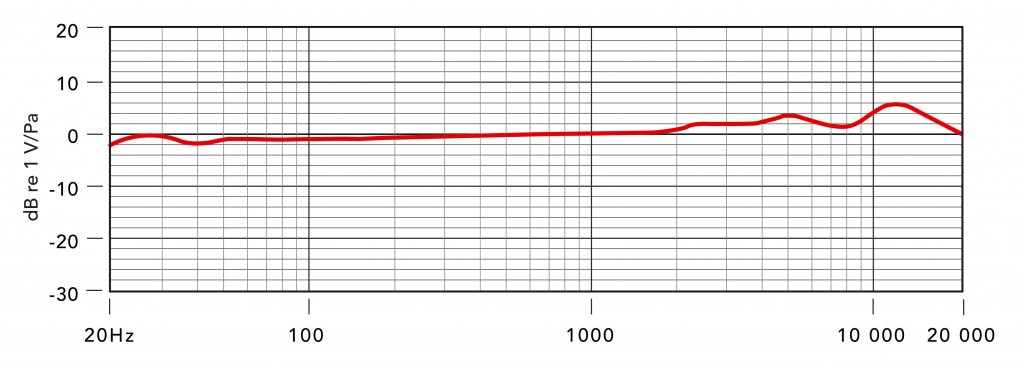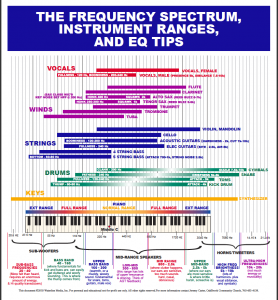HOW MICROPHONES WORK
A microphone is a form of transducer, or a device that changes one form of energy into another corresponding form of energy. The same way that the magnets in guitar pickups turn the vibration of the strings into electrical energy, the microphone turns changes in air pressure into an electrical signal. That electrical signal is so minuscule (approximately 1/1,000 of a volt), that an amplifier is needed to bring that signal up to the correct (line) level, or about 1.2 volts. This amplifier, known as a preamplifier (or preamp or pre) can be located inside the microphone itself, on a piece of outboard gear, or on the mixing console.
POLAR PATTERNS
All microphones have at least one polar pattern, or area around the capsule which picks up sound pressure waves. Choosing a microphone with the ideal polar pattern can limit feedback, bleed from other instruments, or other interference which causes issues with a mix. There are five basic polar patterns: Omnidirectional, cardioid, supercardioid, hypercardioid and bi-drectional (or figure-8). The chart to the left outlines these polar patterns, as well as characterizes their differences in terms of pickup radius, rear rejection and sensitivity to background/room noise.
- Omnidirectional: picks up sound from every direction
- Cardiod: picks up sound primarily from in front of the capsule, with slight rear-end pickup
- Supercardioid: picks up sound primarily in front, with moderate rear-end pickup
- Hypercardioid: picks up sound primarily in front, with a good deal of rear-end pickup
- Bi-Directional (Figure 8): picks up sound in front and behind evenly.
FREQUENCY RESPONSE
All microphones are designed for a specific range of frequencies. This can be either flat (picks up all frequencies evenly) or tailored for a specific purpose, such as low-end or high-end. For low-end instruments such as basses, kick drums and floor toms, choosing a microphone with a low-end bump in its frequency response would be ideal. Conversely, choosing a microphone with a high-end bump in its polar pattern would be ideal for high frequency instruments like cymbals, snare drums and guitars. This frequency response chart shows a relatively flat response, until a small the 1.2kHz range, and a big bump at about 12kHz. Because of this particular microphone’s frequency response, it would be best suited for an instrument with high frequency emissions, especially cymbals or snare drums.
TYPES OF MICROPHONES
There are two main types of microphones: condenser and dynamic.
CONDENSER
Condenser microphones operate on an electrostatic principal, meaning that inside the microphone there are two plates, one movable and one fixed. The sound pressure waves put out by a sound source cause the movable plate to fluctuate, creating an electrostatic charge which then changes the voltage between the two plates. The movable plate is typically made out of a super-thin sheet of Mylar and is sputtered with gold for conductivity. Combined, the two plates function as a capacitor, and are known as the capsule. Condenser microphones also carry an impedance conversion amplifier which is necessary to amplify the signal coming from the capsule and lower the electrical impedance. Because the capsule and the ICA require a constant electrical source in order to operate, condenser microphones require either a battery pack or phantom power in order to function.
TYPICAL PROS:
-Very good frequency response
-Sensitive, and provide a high amount of sonic detail
-Hotter output
-More felixibility with polar patterns, PADS and variable frequency response
TYPICAL CONS:
-Will not handle higher SPLs
-More susceptible to room rumble
DYNAMIC MICROPHONES
Dynamic microphones operate on the principal of electromagnetic induction. This means that a moving conductor (such as a metal wire) through a magnetic field produces an electrical charge in the conductor. The conductor inside dynamic microphones is usually a coil of copper wire, called the voice coil, and is set just behind a Mylar diaphragm. Sound pressure waves emanated by the sound source cause this voice coil to fluctuate inside of a magnet in the capsule of the microphone, which creates the electric current. Unlike condenser microphones which are relatively fragile, dynamic microphones can handle a lot higher sound pressure levels, and are only limited by how far the voice coil can move inside the capsule. Since the sound pressure waves themselves create the electrical charge, a battery pack or phantom power is not required for dynamic microphones (applying phantom power to a dynamic microphone could damage or destroy the microphone).
TYPICAL PROS:
-Decent frequency response
-Durable
-Higher SPL limits
TYPICAL CONS:
-Does not have the level of detail a condenser microphone offers
-Can be damaged or destroyed by phantom power
CHOOSING THE RIGHT MICROPHONE
Knowing what we now know about microphones and how they work, we are capable of making some informed decisions in regards to selecting the right microphone for the job. While microphone selection is primarily based on personal preference, there is still an element of science involved in the decision making process. Specifically, in the area of frequency response. The graphic below shows the frequency ranges for a multitude of instruments, and you can then compare that graphic to frequency response charts of microphones to make a wise decision in selecting the most appropriate microphone.
Here are some common microphone choices for instruments in a worship setting. Please note that these are only recommendations, and not the end-all-be-all for microphone selection on these instruments:
Kick Drum: AKG D112 or Shure Beta 52
Snare Drum: Shure SM57
Rack Toms: Audio Technica AT23HE
Floor Toms: Audix D2
Hi-Hat: AKG C451B
Overheads: Nuemann TLM103 (x2)
Electric Guitar Amplifiers: Shure Beta 57 or SM57
Vocals: Sennheiser EW 165 G3
Other instruments, such as acoustic guitars, bass guitars and keyboards should send signal via a DI (direct input or direct injection) box, and not through a mic’d amplifier.
USEFUL LINKS
For more detailed information on microphone selection, polar patterns, and individual frequency response charts, please visit the guys over at Recording Hacks. They maintain a database of over 1,400 different microphones from 123 manufacturers, with their frequency response charts, polar pattern listings and suggested uses. You can visit their website by clicking here.
Shure microphones also publishes a list of microphone placement and selection suggestions, but all of their information is based around their microphones and may not be viable for non-Shure microphones. You can visit their webpage and check out what they have to say by clicking here.





